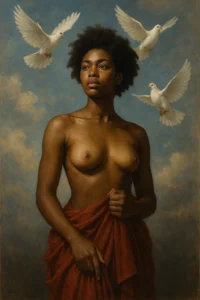
Introduction: Why the Topic of Naked Women Matters
The phrase “naked women” has been searched, debated, and represented across cultures for centuries. From ancient cave paintings to Renaissance art, from feminist movements to body positivity campaigns on social media, naked women symbolize more than just the absence of clothing. They represent themes of freedom, vulnerability, power, beauty, and identity.
In this article, we’ll explore how naked women have been portrayed in art and society, how cultural attitudes have shifted over time, and how modern conversations about nudity focus on body image, feminism, and self-expression. By humanizing the discussion, this piece aims to separate objectification from artistic, cultural, and personal meaning.
(Internal link suggestion: Learn more about SEO, digital culture, and modern content strategies on RankRise1)
1. Naked Women in Ancient Art and Early Civilizations
The earliest depictions of naked women appear in prehistoric cave art and fertility figurines. The Venus of Willendorf (c. 28,000–25,000 BCE), for example, is one of the most famous ancient statues of a nude woman.
- Symbolism: These figures weren’t about beauty standards but represented fertility, motherhood, and survival.
- Cultural meaning: Ancient societies often revered naked women as symbols of life, reproduction, and abundance.
In ancient Greece, nude female statues became more common, although men’s nudity was more celebrated. Goddesses like Aphrodite were often portrayed naked, emphasizing beauty and divine femininity.
2. Naked Women in Classical and Renaissance Art
During the Renaissance (14th–17th century), naked women became central subjects in painting and sculpture. Artists such as Sandro Botticelli with The Birth of Venus and Titian with Venus of Urbino celebrated the female nude as both divine and human.
- Renaissance values: Nudity was seen as a return to the natural, the divine, and the beautiful.
- Artistic techniques: Artists studied anatomy to create more realistic depictions of naked women.
- Tension: While admired as art, many works also reflected patriarchal views—portraying women as objects of the male gaze.
3. Naked Women in Modern Media and Pop Culture
The 20th and 21st centuries brought dramatic shifts in how naked women are represented.
- Cinema and photography: Early Hollywood glamorized women in revealing roles. Over time, the rise of the sexual revolution and feminism challenged how women’s nudity was portrayed.
- Advertising: Brands often used the image of naked women for commercial purposes, sparking debates about objectification vs. empowerment.
- Music and entertainment: From album covers to stage performances, nudity became a form of artistic rebellion and identity.
👉 For a modern example of how corporations balance culture and sustainability, see this related article on Starbucks’ new eco-friendly cup.
4. Naked Women in Feminism and Body Positivity
Modern feminist thinkers argue that the portrayal of naked women can either empower or objectify, depending on context:
- Empowerment: Campaigns like Free the Nipple highlight that women should have the same rights to body expression as men.
- Body Positivity: Movements encourage women to embrace their bodies—whether slim, curvy, young, or aging—without shame.
- Social Media: Platforms like Instagram have become battlegrounds where women push against censorship to share artistic nude photography or body-positive images.
This shift moves away from seeing naked women as objects of consumption toward recognizing nudity as self-expression, autonomy, and acceptance.
5. Cultural Differences in Perceptions of Naked Women
Different cultures view nudity in very different ways:
- Western societies: Tend to debate nudity through the lenses of art, sexuality, and freedom of speech.
- Eastern societies: Often link nudity to modesty, tradition, and social values, though contemporary art is shifting perceptions.
- Indigenous cultures: Many traditional groups historically accepted nudity as a natural state, without sexualizing it.
Understanding these cultural perspectives helps us see how naked women are not universally interpreted the same way—they are shaped by history, religion, and societal norms.
6. Naked Women in Digital Culture and Technology
In today’s digital age, the representation of naked women has reached new complexity:
- Art vs. pornography: Online, artistic nude photography often gets blurred with adult content.
- AI and deepfakes: Technology has raised ethical concerns about fake images of naked women created without consent.
- Online communities: Platforms like Reddit host body-positive, artistic, and feminist spaces for women to share nude art and photography safely.
👉 For an authoritative reference on cultural history, see Wikipedia’s article on the Female Nude in Art.
7. Ethical Considerations: Consent and Representation
One of the most critical issues around the portrayal of naked women today is consent.
- Historical absence: Many classical paintings were created by men for male audiences, often silencing women’s own voices.
- Modern awareness: Feminist scholars now emphasize that women should have agency over how their nudity is represented.
- Digital responsibility: Sharing or consuming images of naked women without consent contributes to exploitation.
Thus, any conversation about naked women must be rooted in respect, consent, and cultural sensitivity.
8. Commercial Uses: The Fine Line Between Art and Marketing
Naked women have long been used in advertising—from perfume and fashion to alcohol and film. While effective in grabbing attention, such uses often draw criticism.
For businesses and creators, the key is to:
- Focus on artistic value and empowerment rather than objectification.
- Highlight diversity of body types to support inclusivity.
- Be transparent when using nudity as a marketing tool.
This represents the 5% commercial balance recommended in high-quality blogging content.
Conclusion: Reframing the Image of Naked Women
The story of naked women in art, culture, and society is one of transformation. From fertility icons in ancient times to body positivity campaigns today, nudity has carried powerful meanings of life, freedom, beauty, and identity.
The challenge in the modern world is to shift away from objectification and embrace nudity as an expression of human dignity, creativity, and empowerment. By humanizing the topic, we can approach “naked women” not as a scandalous subject but as an essential lens for understanding culture, history, and self-expression.
(Internal link suggestion: Explore more cultural and digital insights at RankRise1)
Top 10 References (Authoritative Sources)
- Metropolitan Museum of Art – The Female Nude
- The Guardian – Body Positivity Movement
- Smithsonian Magazine – The Venus of Willendorf
- Psychology Today – Nudity and Body Image
- British Museum – Women in Ancient Art
- Time – Free the Nipple Movement
- The Art Story – Feminism and Art
- Wikipedia – Female Nude in Art
- Healthline – Body Positivity and Mental Health
- National Geographic – Human Evolution and Nudity
